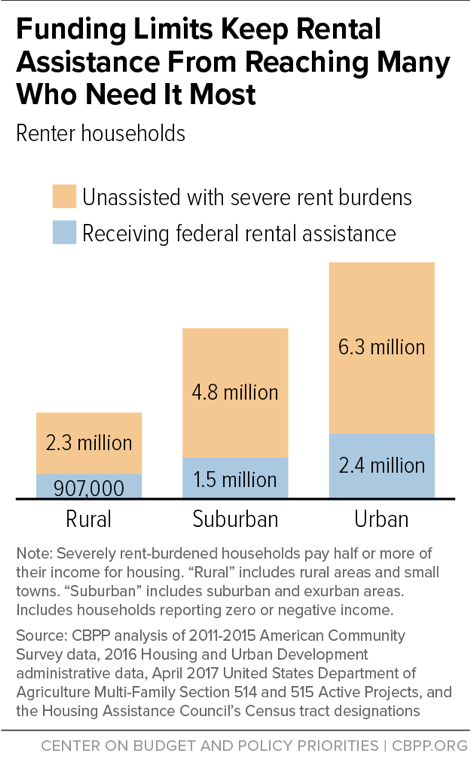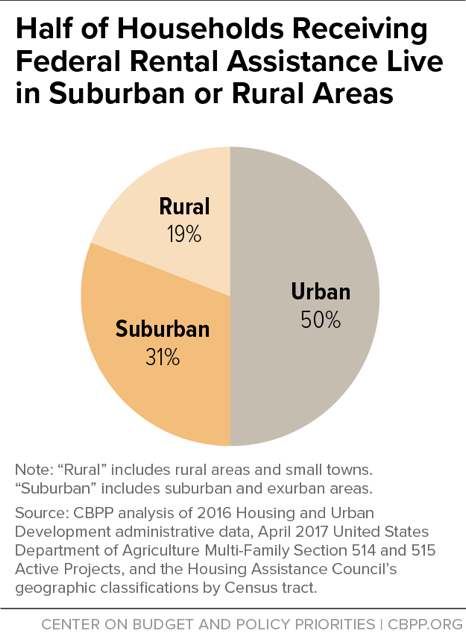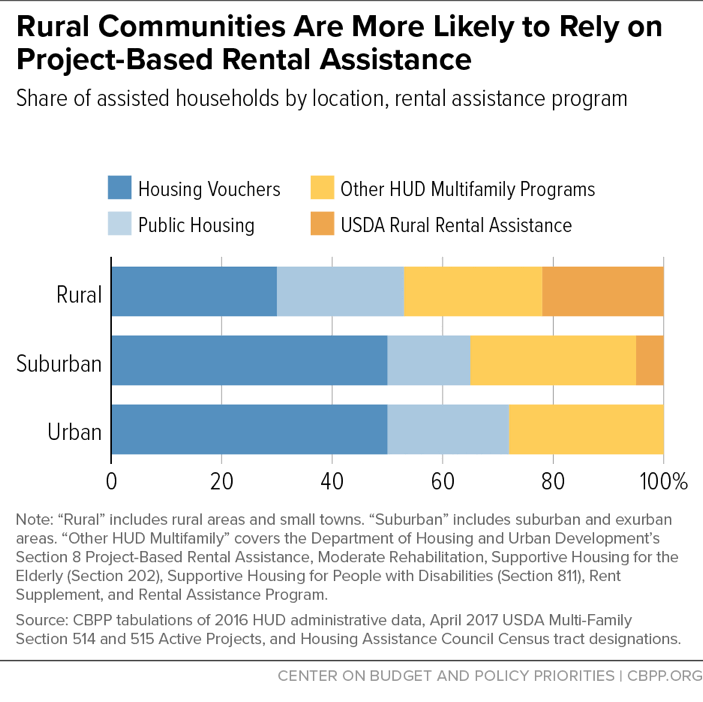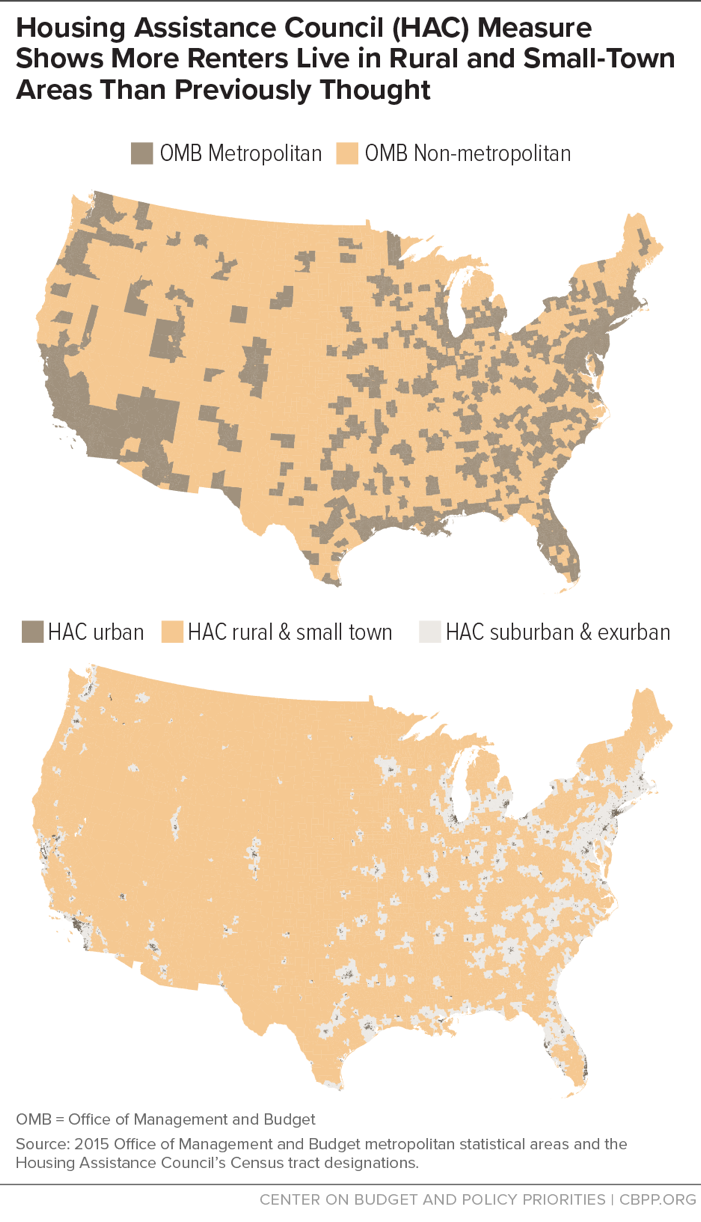Published in partnership with the Housing Assistance Council. Former CBPP housing intern Henry Watson assisted with the data analysis for this report.
Federal rental assistance programs play a vital role in all types of communities — urban, suburban, and rural alike — helping 10 million people in over 5 million low-income households afford stable housing. (See text box below.) However, the vast majority of renters in need in all types of communities do not receive any assistance due to funding limitations. For every assisted household in the United States, there are roughly three renter households paying half or more of their income for housing.
Half of households receiving federal rental assistance live in suburbs or rural areas.[1] Despite the agency’s name, the Department of Housing and Urban Development’s (HUD) rental assistance programs are not exclusive to urban neighborhoods — over 2.1 million suburban and rural households rely on HUD programs to keep a roof over their heads. Similarly, U.S. Department of Agriculture’s (USDA) Rural Rental Assistance supports renters living in both rural and non-rural areas, with nearly 30 percent of households located in suburban and urban areas.
While the amount of available affordable housing falls far short of the need, our new analysis shows that when federally subsidized rental housing programs across HUD and USDA are considered together, assistance is proportionally distributed among communities relative to the types of areas where severely cost-burdened renter households live. (Severely cost-burdened renters pay half or more of their income for housing and do not receive rental assistance.) Half of federally assisted households live in urban neighborhoods, 31 percent live in suburban neighborhoods, and just under a fifth live in rural areas, closely mirroring the location of severely cost-burdened renters. The overall distribution of federal rental assistance is often masked — and can look disproportionate in relation to need — if assisted households across all rental assistance programs are not considered together.
Our new analysis uses geographic definitions developed by the Housing Assistance Council, based on local housing density and commuting patterns. This methodology provides more detail than other measures, such as the Office of Management and Budget’s metropolitan and micropolitan areas. In particular, these definitions identify households living in rural areas, small towns, and suburbs based on more local characteristics (block-by-block housing density and commuting patterns, rather than county-wide characteristics). This may be particularly important in western states (such as California and Arizona) where very large counties can obscure local variation in need.
These data can help national policymakers and analysts better understand who federal rental assistance programs serve and can help state and local policymakers and stakeholders set priorities for their housing investments.
Federal rental assistance is a collection of programs administered by different agencies that enable low-income households to afford modest homes. In each of these programs, families generally pay 30 percent of their income for rent and utilities. The following agencies administer federal rental assistance programs:
Department of Agriculture
- USDA Section 521 Rural Rental Assistance: The Section 521 program provides payments to owners of USDA-financed Rural Rental Housing or Farm Labor Housing projects on behalf of low-income tenants unable to pay their full rent. The USDA provides rental assistance for two-thirds of the units in properties it helps fund, assisting over 270,000 households.
Department of Housing and Urban Development
Three major programs — Housing Choice Vouchers, Public Housing, and Section 8 Project-Based Rental Assistance — assist over 95 percent of HUD households. Other programs serve about 375,000 households with special needs, including the “202” and “811” Supportive Housing Programs for the Elderly and for People with Disabilities; Housing Opportunities for People with AIDS/HIV (HOPWA); and McKinney-Vento permanent housing programs for the homeless. a
- Housing Choice Vouchers: More than 5 million people in 2.2 million low-income households use housing vouchers to help pay for modestly priced, decent-quality homes in the private market. The program is federally funded but run by a network of about 2,000 state and local housing agencies.
- Public Housing: About 2.1 million people in nearly 1 million low-income households live in public housing. While federally funded, public housing is owned and operated by 2,900 local housing agencies nationwide.
- Section 8 Project-Based Rental Assistance (PBRA): PBRA enables 2 million people in 1.2 million households to afford modest apartments by contracting with private owners to rent some or all of the units in their housing developments to low-income families.
Urban, suburban, and rural communities across the country face a severe affordable housing shortage.[2] Yet most renters do not receive any housing assistance, regardless of their location, primarily due to lack of funding. For every assisted household in the United States, roughly three renter households pay half or more of their income for housing across urban, suburban, and rural areas (see Figure 1).
Most of these severely cost-burdened renters have low incomes, earning less than 80 percent of the local median income.[3] An estimated 10.7 million low-income households paid more than half their income for housing in 2015 and did not receive any federal rental assistance.[4]
The poorest renters face the biggest challenge finding affordable housing. There are only 46 adequate, affordable, and available housing units for every 100 extremely low-income renter households — those with incomes at or below the higher of 30 percent of the area median income or the federal poverty line. [5] While this illustrates the severe shortage of affordable housing nationally, the situation would be even more dire in the absence of federal rental subsidies. In the private market, there are just 21 adequate, affordable, and available housing units for every 100 extremely low-income renter households.[6] Federal rental assistance plays a critical role by making more housing affordable in all types of communities.
Although there is huge unmet need for rental assistance across all communities, existing assisted properties and households are proportionally distributed based on need and location (see Figure 2). Nationally, 47 percent of all severely cost-burdened renter households live in urban neighborhoods, 36 percent live in suburban neighborhoods, and 17 percent live in rural areas. Similarly, half of federally assisted households live in urban neighborhoods, 31 percent live in suburban neighborhoods, and just under a fifth live in rural areas. Suburban areas are slightly underserved by federal rental assistance relative to the share of severely cost-burdened renters living in suburban neighborhoods.
Units developed using the Low Income Housing Tax Credit (LIHTC), the nation’s primary source of funds for the creation of affordable rental housing, are slightly more concentrated in suburban neighborhoods relative to unassisted renters who pay half or more of their income for housing. Nationally, 46 percent of all LIHTC units are in urban neighborhoods, 39 percent are in suburban neighborhoods, and 15 percent are in rural areas. Federal law caps rents in LIHTC units at a level that a family earning 60 percent of the local median income can afford without paying more than 30 percent of its income for rent and utilities.
LIHTC units may ease the affordability challenges of some higher-income severely cost-burdened renters; but because LIHTC rents are not based on household income, LIHTC units are rarely affordable to extremely low-income families unless the family also has another form of rental assistance. There is some overlap between LIHTC units and federal rental assistance households. An estimated 50 percent of households living in LIHTC units also receive another form of rental assistance, such as a housing voucher or project-based rental assistance.[7] (For more on LIHTC, see the text box below.)
The Low Income Housing Tax Credit (LIHTC) program, administered by the Treasury Department, is the nation’s primary source of funds for the development of affordable rental housing. Over 2 million units have been placed in service since the program’s creation. The program provides tax credits to developers that agree to build or rehabilitate affordable rental housing, which is generally defined as housing that a family earning 60 percent of the local median income can afford without paying more than 30 percent of its income for rent and utilities. Some LIHTC properties may also include units with market rents. Because LIHTC only subsidizes construction and renovation costs, rents in LIHTC units are rarely affordable to extremely low-income families unless the family also has a voucher or other form of rental assistance. An estimated 50 percent of LIHTC households receive additional federal or state rental assistance. a
The location of federal rental assistance was largely determined prior to 1995, which may explain why some types of communities (and states) are better served than others. From 1965 to 1995, federal rental assistance grew from less than 600,000 units to more than 4.5 million units, about 90 percent of the current supply.[8] Particularly in light of shifting populations in the last 20 years, these units are not distributed equally among states relative to the needy renter population. Regions of the country that developed earlier benefit from older existing public housing stock, while areas that developed later — particularly in some states in the South and West — have a lower prevalence of federal rental assistance.[9] Five such states — Arizona, California, Florida, Nevada, and Texas — contain over a fifth of all severely cost-burdened renters but only about 10 percent of assisted units.[10]
The federal government established the Public Housing program in 1937 and expanded it steadily until the 1980s, peaking at 1.4 million units in 1994.[11] While Public Housing is a form of federal assistance, local governments decided where to build public housing, if they chose to build it at all.[12] The Section 8 tenant-based (voucher) and project-based programs were created in 1974 and expanded to serve nearly 3 million families by the mid-1990s. However, federal programs have added less than 700,000 additional units since then.[13]
Conversely, the LIHTC program is newer, and the number of LIHTC units has grown steadily since its creation in 1986. Credit authority is largely distributed to states based on population. This allocation process adjusts over time for population shifts, though it is not calibrated to respond specifically to state variations in renters’ affordability challenges. States decide where LIHTC properties are located through a competitive process. The LIHTC program initially focused on development in rural areas and older metropolitan neighborhoods.[14] However, additional LIHTC units were built in suburban areas beginning in themid-1990s.[15] Since the mid-2000s, the geographic distribution of new LIHTC units has been stable.
Although rural communities receive their proportional share of assistance relative to need, rural renters face unique challenges because the housing stock generally is in worse condition than in the rest of the country.[16] Rural renters are more likely to encounter physical housing problems, such as inadequate plumbing, heating, or electricity. More than 30 percent of homes lacking hot and cold piped water are in rural and small-town communities. Some of the physical deficiencies stem from age and lack of upkeep, as 35 percent of rural renter-occupied units were built before 1960.[17]
Over 2.4 million households receiving federal rental assistance — half of all assisted households — live in suburban and rural communities (see Figure 3). HUD programs, which provide roughly 95 percent of all federal rental assistance, help 2.1 million suburban and rural households keep a roof over their heads. USDA Rural Rental Assistance shelters the remaining 277,000 assisted suburban and rural households.
Despite the agency’s name, 47 percent of all HUD-assisted households reside in suburban and rural areas. Similarly, nearly 30 percent of those receiving assistance through USDA Rural Rental Assistance live in urban or suburban areas. In addition, most LIHTC units are in suburban or rural communities, with close to 40 percent of units located in the suburbs. (See Appendix 3 for detailed geographic breakdowns by program, including individual programs by state.)
Although assisted households are roughly split between urban and non-urban areas nationally, the picture varies greatly among individual states. In very rural states like Vermont, the majority of households in each federal rental assistance program live in rural communities, ranging from 56 percent of voucher households to 97 percent of USDA households. The opposite is true in more densely populated states like Massachusetts and Maryland, where HUD rental assistance programs predominantly serve urban households and USDA programs serve a significant portion of suburban households.
While federal rental assistance helps all types of communities, project-based programs play a larger role in rural areas. Seventy percent of federal rental assistance in rural communities is from project-based programs like USDA Rural Rental Assistance, HUD Public Housing, and HUD project-based multifamily programs. USDA Rural Rental Assistance plays an especially important role in rural areas, supporting close to a quarter of assisted households.
Rental assistance in urban and suburban neighborhoods is evenly split between tenant-based programs (i.e., Housing Choice Vouchers) and project-based programs (see Figure 4). Public Housing and other HUD project-based multifamily programs are the primary sources of project-based rental assistance in urban and suburban areas.
The Housing Choice Voucher program is the largest source of rental assistance overall and in urban, suburban, and rural areas. Voucher-assisted households make up roughly 30 percent of federal rental assistance recipients in rural areas, and half of all recipients in suburban and urban neighborhoods (see Appendix 3).
We used geographic definitions developed by the Housing Assistance Council (HAC). HAC classifies Census tracts into six community types: 1) rural, 2) small-town, 3) exurban (e.g. beyond the suburbs but not rural), 4) outer suburban, 5) inner suburban, and 6) urban. Categories are defined using housing density and commuting patterns.
- Rural areas are Census tracts with less than 16 housing units (owned or rented) per square mile.
- Small-town areas are Census tracts with 16 to 64 housing units per square mile and a low degree of commuting to a metropolitan core area identified by a USDA Rural Urban Commuting Area Code score of 4 or higher. [18]
- Exurban areas are Census tracts with 16 to 64 housing units per square mile and a high degree of commuting to a metropolitan core area identified by a USDA Rural Urban Commuting Area Code score of 3 or lower.
- Outer suburban areas are Census tracts with 65 to 640 housing units per square mile.
- Inner suburban areas are Census tracts with 641 to 1,600 housing units per square mile.
- Urban areas are Census tracts with more than 1,600 housing units per square mile.
For simplicity, we use the term “rural” to refer to rural and small-town tracts as a group, and “suburban” to refer to exurban, outer suburban, and inner suburban tracts as a group.
For more details on these geographic designations, please see HAC’s Rural Data Portal http://www.ruraldataportal.org/geoterms.aspx.
Comparison to metropolitan and non-metropolitan area measures: The Office of Management and Budget (OMB) publishes official definitions of metropolitan areas. Metropolitan statistical areas have at least one urbanized area of 50,000 or more people, plus adjacent territory that has a high degree of social and economic integration with the core as measured by commuting ties. Metropolitan areas are defined in terms of counties or county equivalents.[19] Non-metropolitan areas — areas falling outside of metropolitan counties — are often used as a proxy for rural areas. In the past, CBPP has used these designations to differentiate between rental assistance located in “urban” (i.e. metropolitan) and “rural” (i.e. non-metropolitan) areas.
However, metropolitan and non-metropolitan measures can be misleading, particularly in a housing context. Rural areas share the common characteristics of comparatively few people living in an area, limited access to large cities (and sometimes even to smaller towns), and considerable travel distances to “market areas” for work and everyday living activities.[20] But it is not necessarily the case that any given non-metropolitan area will have these characteristics. By categorizing entire counties as metropolitan or non-metropolitan, OMB’s designations do not capture the geographic variation within many counties. This is particularly problematic in western states where counties can be very large and can encompass several types of communities within the same county (see Figure A1). In many cases, HUD modifies OMB’s metropolitan designations to create smaller HUD “metropolitan” areas for the purpose of setting local median incomes and fair market rents.
HAC’s geographic designations offer a more granular measure of community types. Its measure incorporates data on housing density and commuting patterns by Census tract, instead of by county. Census tracts are small, relatively permanent statistical subdivisions of a county or equivalent entity, and generally have a population size between 1,200 and 8,000 people.[21] Compared to the OMB metropolitan and non-metropolitan measures, HAC’s designations identify a larger number of renters as living in rural and small-town areas. This may be particularly important in western states (such as California and Arizona) where very large counties can obscure local variation in need. See Table A1 and Figure A1.
| TABLE A1 |
|---|
| Comparing Measures of Rural and Non-Metro Renter Households |
|---|
| |
Share in OMB Non-Metropolitan Areas |
Share in HAC Rural or Small-Town Tracts |
|---|
| Severely Cost-Burdened Renter Households |
12% |
17% |
| Federal Rental Assistance Households |
14% |
19% |
| Low Income Housing Tax Credit Units |
12% |
15% |
Severely cost-burdened renters without rental assistance: Data on severely cost-burdened renter households by Census tract are from the 2011-2015 American Community Survey, Table B25070, Gross Rent as a Percentage of Household Income in the Past 12 Months. A household is considered severely cost-burdened if it pays 50 percent or more of its monthly income on rent and utilities. We consider households with zero or negative incomes to be severely cost-burdened, even though it is not mathematically possible to calculate the share of income these households spend on housing.
To qualify for federal rental assistance, a household generally must earn less than 80 percent of the local median income. The vast majority — 98 percent — of severely cost-burdened renters (11 million households) have low incomes. Due to data limitations, we are unable to exclude the roughly 163,000 higher-income households with severe cost burdens from this analysis.
We estimated the number of unassisted severely cost-burdened renter households by subtracting roughly 240,000 severely cost-burdened households receiving HUD rental assistance from the ACS estimates.[22] (The ACS does not include information on receipt of rental assistance.)
Households receiving HUD rental assistance: Data on the location of HUD-assisted households are from a 2016 non-public dataset from the HUD Office of Policy Development and Research, available through a research agreement. This dataset contains demographic and location information collected through HUD Form 50058 and the Tenant Rental Assistance Certification System. The dataset includes households in the following programs as of December 2016:
- Public Housing
- Section 8 Housing Choice Vouchers
- Section 8 Project-Based Rental Assistance
- Moderate Rehabilitation
- Supportive Housing for the Elderly (Section 202)
- Supportive Housing for People with Disabilities (Section 811)
- Rent Supplement
- Rental Assistance Program
Location data were missing for 14,000 households (mostly in the voucher program) out of roughly 4.5 million total households.
This dataset does not include the location of households receiving rental assistance through McKinney-Vento Permanent Supportive Housing, Safe Haven, and Transitional Housing or Housing Opportunities for Persons with AIDS. These omitted programs only make up 4 percent of households receiving HUD rental assistance.
USDA Rural Rental Assistance units: We used the USDA’s Multi-Family Section 514 and 515 Active Projects[23] list from April 2017 to determine the location of units subsidized under the Section 521 Rural Rental Assistance program. Location data were missing for less than 50 units out of 282,000 total units.
LIHTC units: We used HUD’s Low Income Housing Tax Credit Database[24] to determine the location of low-income units in LIHTC projects placed in service through 2015. Approximately 192,000 low-income units continue to appear in the database but are no longer being monitored for affordability due to expired contracts. For the purposes of this analysis, we assumed these units continue to be affordable based on the program rules (i.e., the rents are typically capped at 30 percent of income of households at 60 percent of the local median income). Location data were missing for roughly 123,000 low-income units out of 2.3 million total units.
The following state-by-state data provides policymakers and others with information about how rental assistance overall, assistance within particular programs, and LIHTC units are distributed within each state.






